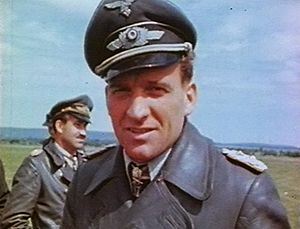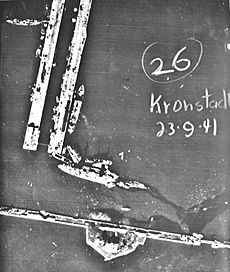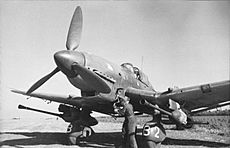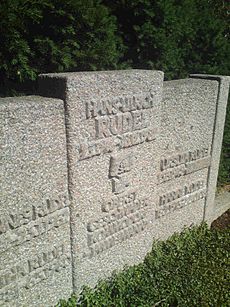Hans-Ulrich Rudel facts for kids
Quick facts for kids
Hans-Ulrich Rudel
|
|
|---|---|

Hans-Ulrich Rudel in 1945
(Adolf Galland in the background) |
|
| Born | 2 July 1916 Konradswaldau, German Empire |
| Died | 18 December 1982 (aged 66) Rosenheim, West Germany |
| Buried |
Dornhausen
|
| Allegiance | |
| Service/ |
Luftwaffe |
| Years of service | 1936–1945 |
| Rank | Oberst (colonel) |
| Unit | StG 3, StG 2 |
| Commands held | SG 2 |
| Battles/wars | World War II |
| Awards | Knight's Cross of the Iron Cross with Golden Oak Leaves, Swords, and Diamonds |
| Other work | Founder of relief organization for Nazi war criminals Neo-Nazi activist Election candidate from the extremist German Reich Party |
Hans-Ulrich Rudel (born July 2, 1916 – died December 18, 1982) was a German pilot during World War II. He was famous for flying ground-attack missions. After the war, he became involved in far-right politics.
Rudel was the most decorated German pilot of the war. He was the only person to receive the Knight's Cross with Golden Oak Leaves, Swords, and Diamonds. He was credited with destroying 519 tanks, one battleship, one cruiser, 70 landing craft, and 150 artillery positions. He also claimed nine air victories and the destruction of over 800 vehicles.
He flew 2,530 missions, mostly on the Eastern Front. He usually flew the Junkers Ju 87 "Stuka" dive bomber.
Rudel surrendered to American forces in 1945 and later moved to Argentina. He helped some people who were wanted after the war to escape to Latin America and the Middle East. He also worked as a seller of military equipment to some governments in South America. The US Central Intelligence Agency watched him because of these activities.
In the West German federal election of 1953, Rudel was a top candidate for a far-right political party, the German Reich Party. However, he was not elected. After Juan Perón's government fell in Argentina, Rudel moved to Paraguay. There, he worked as a representative for several German companies.
In 1976, Rudel attended a meeting in the United States. He met with members of the US military and the defense industry. His experience in destroying Soviet tanks from the air was helpful for designing new planes. This included the A-10 Thunderbolt II.
Contents
Early Life and Joining the Air Force
Hans-Ulrich Rudel was born on July 2, 1916, in Konradswaldau, which was then part of Prussia. He was the third child of Johannes Rudel, a Lutheran minister. As a boy, Rudel was not a great student, but he loved sports.
He went to a Gymnasium (a type of high school) in Lauban. In 1933, he joined the Hitler Youth. After finishing school in 1936, he took part in the required Reich Labour Service. Later that year, Rudel joined the Luftwaffe (German air force). He started his military career as a pilot who flew planes to gather information.
World War II Missions
In 1939, German forces invaded Poland, which started World War II in Europe. Rudel flew long-range missions over Poland as an air observer. In 1940, he worked as an assistant for a training regiment in Vienna.
In early 1941, he trained to become a Stuka pilot. He was sent to a unit called 1 Staffel Sturzkampfgeschwader 2 (StG 2). This unit moved to occupied Poland to prepare for Operation Barbarossa. This was the invasion of the Soviet Union in June 1941.
On September 21, 1941, Rudel took part in an attack on the Soviet battleship Marat. The Marat was sunk on September 23, 1941. It was hit by a 1,000 kg bomb near the front. This caused an explosion that destroyed part of the ship. 326 men died, and the ship sank in 11 meters of water. Rudel is often given credit for sinking the Marat, but he dropped only one of the two bombs that hit it. His unit then took part in Operation Typhoon, which was an attempt to capture the Soviet capital.
From October 1941, Erwin Hentschel was Rudel's gunner. They flew together for two and a half years. Both men earned the Knight's Cross of the Iron Cross during this time. Hentschel flew 1,400 missions with Rudel. He drowned on March 21, 1944, while they were trying to get back to German lines after their plane made an emergency landing.
In early 1942, Rudel got married while on leave. Later that year, he fought in the Battle of Stalingrad. From May 1941 to January 1942, Rudel flew 500 missions. In February 1943, he flew his 1,000th combat mission, which made him a national hero. He then helped test the Ju 87 G plane for fighting tanks. This anti-tank unit fought in the Kerch–Eltigen Operation. Videos from an onboard camera were shown in Die Deutsche Wochenschau, a German newsreel.
In April 1943, Rudel received the Knight's Cross of the Iron Cross with Oak Leaves. Hitler himself gave him this award in Berlin. Rudel also fought in the Battle of Kursk with the same unit. On July 12, 1943, Rudel claimed to have destroyed 12 Soviet tanks in one day. In October 1943, he was credited with destroying his 100th tank. On November 25, he received the Knight's Cross of the Iron Cross#Knight's Cross with Oak Leaves and Swords (only 160 were given out).
Rudel became a commander of a group called III. Gruppe on February 22, 1944. On March 20, Rudel had to land his plane behind Soviet lines. He and Hentschel escaped to German lines. They tried to swim across the Dniester River, but Hentschel drowned. After Rudel returned, Ernst Gadermann, who was a doctor in his unit, became his new radio operator and gunner. On March 29, 1944, Rudel received the Knight's Cross of the Iron Cross#Knight's Cross with Oak Leaves, Swords, and Diamonds (only 27 were given out). He was the tenth person in the German army to get this award. Hitler personally presented it to him.
Rudel was promoted to Oberstleutnant (lieutenant colonel) on September 1, 1944. On October 1, 1944, he became the leader of SG 2. On December 22, 1944, Rudel completed his 2,400th combat mission. The next day, he reported destroying his 463rd tank. On December 29, 1944, Rudel was promoted to Oberst (colonel). He also received the Knight's Cross of the Iron Cross#Knight's Cross with Golden Oak Leaves, Swords, and Diamonds. He was the only person to ever receive this award. This award was meant to be one of 12 given after the war, but he received it on January 1, 1945. This was four months before Nazi Germany was defeated.
On February 8, 1945, Rudel was badly wounded in his right foot. He landed his plane inside German lines with his radio operator shouting instructions. Rudel's leg was amputated below the knee. He returned to flying on March 25, 1945. He claimed to have destroyed 26 more tanks by the end of the war. On April 19, 1945, Rudel met with Hitler in his bunker in Berlin. On May 8, 1945, Rudel flew west from an airfield near Prague. He landed in US-controlled territory and surrendered. The Americans did not hand him over to the Soviet Union.
Life After the War
After the war, Rudel's family fled from the Soviet army. They found safety with Gadermann's parents. Rudel was released in April 1946 and started a private business. In 1948, he moved to Argentina. He traveled through Austria and Italy, using a fake Red Cross passport. He arrived in Buenos Aires on June 8, 1948. Rudel wrote books about the war, supporting the Nazi regime.
In South America
In Argentina, Rudel became a close friend of Juan Perón, who was the President of Argentina. He also befriended Alfredo Stroessner, the dictator of Paraguay. In Argentina, Rudel started an organization called "Kameradenwerk". This group helped people who were wanted for war crimes. The group helped many people escape to Argentina. They also sent food and paid legal fees for Nazi criminals in Europe. Rudel met Josef Mengele, a doctor from a concentration camp, in Argentina. Rudel helped Mengele move to Brazil. In 1957, Rudel and Mengele traveled to Chile to meet Walter Rauff, who invented mobile gas chambers.
Rudel lived in Villa Carlos Paz, near Córdoba City. He rented a house and ran a brick factory. There, Rudel wrote his war memories called Trotzdem ("Nevertheless"). This book was published in November 1949. The Dürer-Verlag publishing company, which published books by former Nazis, published it.
There was a debate in West Germany about whether Rudel should be allowed to publish his book. In the book, he supported Nazi ideas. This book was later published in the United States as Stuka Pilot. It supported the German invasion of the Soviet Union. In 1951, he wrote a pamphlet claiming that Germany's war against the Soviet Union was a "defensive war" and a "crusade for the whole world."
With help from Perón, Rudel got good contracts with the Brazilian military. He also worked as a military advisor and sold weapons to governments in Bolivia, Chile, and Paraguay. He was in contact with Werner Naumann, a former official in the Nazi government. After Perón's government fell in 1955, Rudel had to leave Argentina and move to Paraguay. In South America, Rudel often worked as a representative for several German companies. These included Salzgitter AG, Dornier Flugzeugwerke, Focke-Wulf, Messerschmitt, and Siemens.
According to historian Peter Hammerschmidt, Rudel helped connect a German company called Merex with former Nazi officials. Merex sold old German military equipment to dictators in Latin America. Rudel also helped set up a company called "La Estrella" (The Star) with Friedrich Schwend and Klaus Barbie. This company hired former Nazi officers who had fled to Latin America. Rudel was also in contact with Otto Skorzeny, who had his own network of former Nazi officers.
Rudel returned to West Germany in 1953. He became a leading member of a far-right political party, the German Reich Party (DRP). In the 1953 West German federal election, Rudel was the top candidate for the DRP, but he was not elected. In his political speeches, Rudel claimed to speak for most German soldiers of World War II. He criticized the Western Allies for not supporting Germany against the Soviet Union. Rudel's political views caused him to lose touch with his former friends. In 1977, he became a spokesman for the German People's Union, a nationalist political party.
Personal Life and Death
Rudel was married three times. His first marriage in 1942 was to Ursula Bergmann, nicknamed "Hanne." They had two sons, Hans-Ulrich and Siegfried. They divorced in 1950. One reason for the divorce was that his wife had sold some of his awards to an American collector. She also refused to move to Argentina.
Rudel married his second wife, Ursula Daemisch, in 1965. They had a son named Christoph in 1969. Rudel had a stroke on April 26, 1970, but he survived. After divorcing in 1977, he married Ursula Bassfeld.
Hans-Ulrich Rudel died after another stroke in Rosenheim on December 18, 1982. He was buried in Dornhausen on December 22, 1982. During his funeral, two German military planes, F-4 Phantoms, flew low over his grave. Officials said it was a normal training flight. Four people at the funeral were photographed giving Nazi salutes. They were investigated under a law that bans the display of Nazi symbols.
Military Achievements
Rudel flew 2,530 combat missions on the Eastern Front during World War II. Most of these were in the Junkers Ju 87. He also flew 430 missions in the Focke-Wulf Fw 190 ground-attack planes. He was credited with destroying 519 tanks. He also severely damaged the battleship Marat. He was also credited with sinking a cruiser (the damaged Petropavlovsk), a destroyer (the Minsk), and 70 landing craft.
Rudel also claimed to have destroyed over 800 vehicles, more than 150 artillery or anti-aircraft positions, and 4 armored trains. He also destroyed many bridges and supply lines. Rudel was credited with 9 air victories, including 7 fighter planes and 2 Ilyushin Il-2s. He was shot down or forced to land 30 times due to anti-aircraft fire. He was wounded five times and rescued six stranded aircrew from enemy territory.
Rudel received many awards, including:
- Honor Goblet of the Luftwaffe (October 20, 1941)
- Iron Cross (1939) 2nd Class (November 10, 1939) & 1st Class (July 15, 1941)
- Knight's Cross of the Iron Cross with Golden Oak Leaves, Swords, and Diamonds
- Knight's Cross on January 6, 1942
- 229th Oak Leaves on April 14, 1943
- 42nd Swords on November 25, 1943
- 10th Diamonds on March 29, 1944
- 1st, and only, Golden Oak Leaves on December 29, 1944
- Pilot/Observer Badge In Gold with Diamonds
- Wound Badge In Gold
- German Cross In Gold
- Front Flying Clasp of the Luftwaffe in Gold with Diamonds and a badge for 2,000 missions
- Wehrmacht Long Service Award 4th class
- Sudetenland Medal
- Eastern Front Medal
- Silver Medal of Military Valor (Italy)
- 8th (1st and only foreign) Hungarian Gold Medal of Bravery (January 14, 1945)
In Popular Culture
Rudel remained popular with far-right groups in Germany after his death. Especially with the German People's Union (DVU) and its leader Gerhard Frey. In 1983, Frey and the DVU created the Ehrenbund Rudel (Honour federation Rudel) during a memorial service for Rudel. British Holocaust denier David Irving received the Hans-Ulrich Rudel Award from Frey in June 1985. He also gave a speech remembering Rudel.
See also
 In Spanish: Hans-Ulrich Rudel para niños
In Spanish: Hans-Ulrich Rudel para niños




